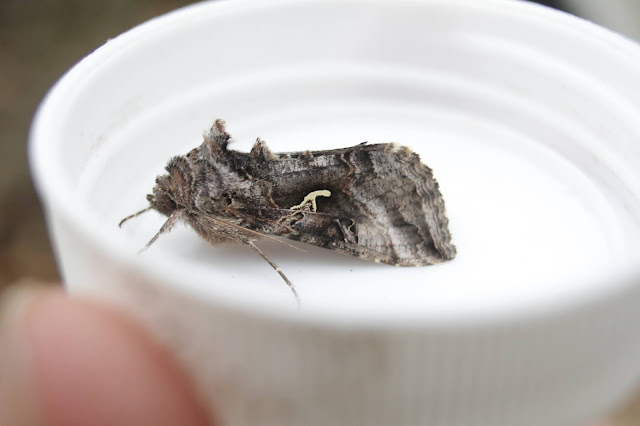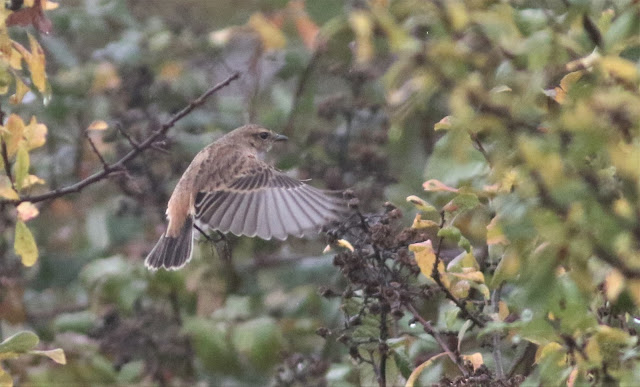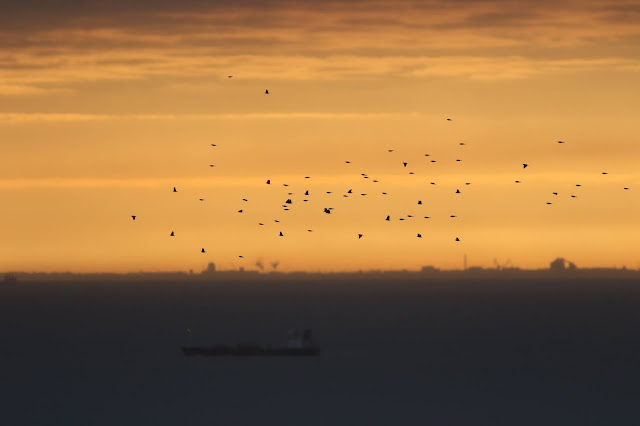Sunday, 29 November 2020
Beddington Farmlands Bird and Wildlife Report 2019
Saturday, 28 November 2020
Identification of Azores Gull- Dutch Birding Paper
Our paper on the Identification of Azores Gull recently published in Dutch Birding is now available to view HERE on Research Gate.
Non-stop Birding Publications Page updated HERE
Reference: Identification of Azores Gull by Peter Adriaens, Peter Alfrey, Chris Gibbins, Daniel Lopez-Velasco, Dutch Birding 42 (5): 303-334
Tuesday, 24 November 2020
Corvo 2020- Results
I just remembered I forgot to post the results of Corvo 2020 on this blog. See our Corvo blog HERE.
This was the first time in 20 years that I didn't visit the Azores (due to Covid considerations) for autumn birding/rarity hunting and the first time in 15 years that I didn't go to Corvo. Fortunately a few brave die-hards manned the rock and the haul was not too bad especially considering the low numbers of birders and the overall rather unfavourable weather conditions with long periods of easterlies.
Results table below (David Monticelli)
To read our most recent main paper (to include analysis up to 2017) on this project see our 2018 Dutch Birding feature HERE
Monday, 23 November 2020
The Azores Rare and Scarce Bird Report 2017- Out now
Tuesday, 17 November 2020
Old Vicarage Weekend
A rather slow weekend here on the Oxon/Bucks border. Managed to visit Farmoor Reservoir this morning (wasn't sure if the Covid Gestapo would lynch me but seems like okay to travel and exercise- I'm genuinely not sure so took the benefit of the doubt to twitch a Oxfordshire tick). The rest of the weekend was spent working on the Azores Rare Bird Reports and Portuguese Rarities Committee work and a bit of time in the garden planning the new moth and butterfly bed.
No Ebird lists yet as Ebird is down for maintenance at the moment. Moth trap was quiet, just a few December moths, Silver Y and Grey-pine Carpet.
Adult female Scaup, presumably a returning bird from last year (SEE HERE ). Also a juvenile Scaup and male Tufted Duck. The juvenile bird was smaller than the female and also lacked a white ear covert patch (more typical of classic juv Scaup). See some cautious remarks in this caption link above.Friday, 13 November 2020
Beddington Farmlands- plastic fantastic
Been working in London for last few days. Seems like the theme has been Category C and E birds with a Yellow-crowned Bishop and the White Stork (GB35) at Beddington today and a count of over 1000 Ring-necked Parakeets going to roost yesterday evening. Ebird list HERE.
The evenings have been fairly mild with a few moths including Feathered Thorn, Chestnut and Silver Y.
Tuesday, 10 November 2020
Old Vicarage- Winter lockdown
Hopefully should be a busy winter here at the Old Vicarage. Bryan (Holly's dad) is getting a conversion done on the Coach House and at the same time the garden area is being extended and also got some plans to plant up some pollinator borders. Should keep us busy through lockdown as can't get much food growing done this time of year (but going to try some broad beans) so mainly planting and landscaping time.
Had the noc-mig gear out over last few nights (calm evenings have been a bit rare this autumn)- been good numbers of Redwings and also a few migrants including Teal, Coot and a garden first - Snipe. Snipe recording below and a few recordings HERE (interesting comparison of two redwing NFCs- showing differences in sonogram signatures.)
The moth trapping has been pretty good for this time of year. The small flush of migrants continue over the last couple of nights with up to 4 Silver Y, single Rusty-Dot Pearls and Turnip. Also a late Setaceous Hebrew Character (which could be a migrant too). Local fair include up to five Feathered Thorns, Chestnuts, Cypress and Red-Green Carpets, Sprawlers, Blair's Shoulder Knots, Satellite and December moth etc.
Monday, 9 November 2020
The EBird Revolution
Any regular follows of this blog will know that I use Ebird as my bird recording system. Dom Mitchell wrote a somewhat controversial article in Birdwatch/Birdguides recently HERE where he advocated the replacement of notebooks with the Ebird app. I might even go a bit further than that and will predict that Ebird will not only replace notebooks but also will replace bird reports, county recorders, bird clubs, rarities committees and every other traditional birding recording, validation and reporting platform eventually.
At Beddington Farmlands we've attempted to completely make the transition to Ebird with observers using the app to populate our hotspot with data, photos and sound recordings and we've also been uploading archived data to create a 'live' avifauna of the site. Although it's still a work in progress here are the results:
Beddington Farmlands Location and Introduction: HOTSPOT MAP
The Beddington Farmlands avifauna (on line bird history of the site) ILLUSTRATED CHECKLIST and PRINTABLE CHECKLIST
2020 Live Bird Report: 2020 BAR CHARTS (any year can be selected by changing the date range)
Example of Species account: GREEN SANDPIPER 2020 DATA (any species can be selected and analysed in multiple ways by clicking on graph icon next to each species on the bar chart)
Example of species records in comparison to surrounding hotspots: ARCTIC SKUA (if you zoom out of this map it looks like there was only two other inland records on Arctic Skua in England in 2020- in Staines and Cambridge)
Photos for 2020 at Beddington Farmlands BEDDINGTON FARMLANDS MEDIA
Sound recordings for 2020 at Beddington Farmlands BEDDINGTON FARMLANDS SOUND MEDIA
Example of a daily recording sheet APRIL 18th 2020 EBIRD
Basically, Ebird is absolutely amazing and thrusts birding into the digital, global and interconnected future. Each local patch and all local data is effectively integrated into a global recording system which maps global bird distribution and migration in real time. It's a global revolution and within the next ten or twenty years it will absorb rarity committees (national and county), reports and records centres.
To make sure we move into the future but not lose great traditions we will still produce a hard copy bird report at Beddington but a concise version which supports the Beddington Farmlands Ebird. Example of our transition with our 2019 report HERE (on ResearchGate- another open source global network for scientific research). All this new technology really is absolutely amazing!!
Check out the Azores Ebird, planning on integrating our reports here too. AZORES EBIRD. This is a really important function where recording areas can be constructed and individual records can be analysed across collections of hotspots (e.g. no reason a county can't adopt one of these recording areas). Will also be building our Bulgaria and Ghana projects on Ebird and also use it for all birding trips, home and away- the benefit of a global/ universal system.
Sunday, 8 November 2020
The Old Vicarage- a few migrant moths
Wednesday, 4 November 2020
The Late show
Winter is coming but autumn is not over yet. Woodpigeons have been on the move in the last couple of days with about 1000 per hour going over the Beddington obs this morning. I did Otmoor yesterday morning which was all gearing up for the winter with well over 1000 Golden Plovers on Flood Field and flocks of Wigeon building on Big Otmoor. Also had 1 Dunlin in with the plovers and about 30 Snipe out on Greenaways.
December moths in the moth trap at the Old Vic - another harbinger of four months of winter.
With lockdown re-starting tomorrow it could well be a very long winter. Local nature could well be a vital lifeline (a natural intensive care unit) in the coming weeks and months.
Tuesday, 3 November 2020
Sunday, 1 November 2020
Big October round-up
Well, overall quite pleased with my 'Big October'. The plan was to take the whole month off and try and find some rare birds and moths. It didn't quite go to plan as work was so busy I had to go back one or two days a week. However did manage to find a couple of local megas, a BB rarity, a few national scarcities and a few migrant moths.
This was the first autumn I've birded the UK since the early 2000's. Each year since 2005 I've been 'doing' the Azores and more recently the Black Sea coast in September/October so it was a bit like going back in time. What was very evident while re-visiting rarity hunting spots in Kent and locally was how much birding has evolved in the last 20 years. Rarity hunting in the Uk in early 2000s was just bins, scope, tripod and a Nikon Coolpix 995 and then back home to deal with reporting news, catching up with news and identification from books and journals etc.
Now I had bins, scope, tripod, DSLR camera with 300mm lens, Iphone, sound recording set up (recorder, headphones and shotgun mic) and was based in the VW campervan aka mobile obs/lab with laptop, internet hotspot, charging points, robinson's moth trap and actinic heath trap, with spare bulbs, entomology equipment, batteries while connected via the iphone to a whole network of whatsapp and social media groups (for bird and moth news), bird news app (Birdguides), bird recording app (Ebird) and access to sound and image resources (Xeno Canto, Macaulay Library, UK Moths, Norfolk moths, Hampshire Moths) and a whole range of weather map apps and birdcasts etc and writing the whole thing up on blogs connected to embedded networks . It's nuts- the next 20 years is almost unimaginable- presumably we are going to be thrust back into the dark ages as Captialsim overshoots and collapses with all this wonderful technology it has delivered to keep us amused and rebuild the planet and society following a period of dictactorship, devastation and genocide. How can you possibly advance from here? There's nowhere to go apart from back surely?? Oh yes I forgot that we are also awaiting a DNA result from a faecal sample that is currently being analysed by scientists in Aberdeen before we can identify one bird I found ! WTF!!
Anyway, despite the sense of impending doom (and Covid lurking and rising in the background) it was great fun as I was walking around lit up like a xmas tree with lights flashing and phones beeping , wires everywhere, bits of gear hanging off of every limb while simultaneously talking to friends in the Azores, Bulgaria, the Scillies and across the UK comparing notes and discussing weather patterns. Bloody amazing. Literally what a great time to be alive (maybe for not much longer!)
Here's a few photo highlights of a fantastic month.


















































